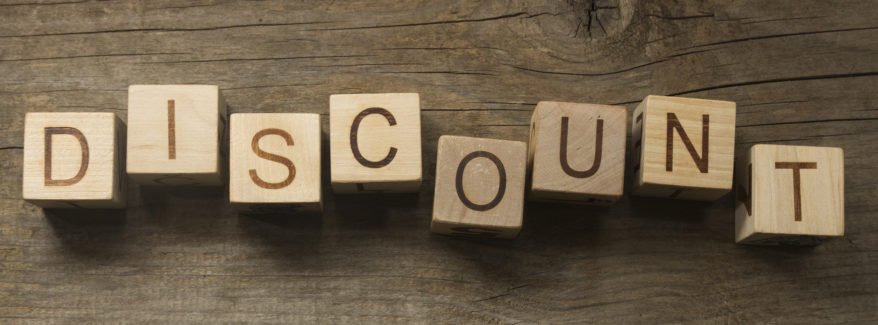Rolex with 30% discount? Or: Why luxury manufacturers don't give discounts and what you as a salesperson can learn from this!

Everyone is happy as a buyer when he gets discounts, because thus the feeling of having made a good deal increases massively. Thus, discounts are an important tool in negotiations, which, if used correctly, can have very positive effects on your sales. However, the greater your pleasure of a discount, the greater the workload for the seller behind it can be, because discounts affect much more than just the price.
Discounts as a sales strategy?
Does the topic of “discounts” fit your market strategy, your image and your products? Sales in the B2C and B2B sectors differ considerably in some respects. A discount on shirts or other products in the B2C sector is something different than a percentage on measuring devices in the B2B sector. And if you, as an end consumer, think about negotiations for a loan or a house purchase or about the negotiations for the last car purchase? Everyone knows that the first offers are just wastepaper and that the percentages offered are planned in advance. The actual negotiations begin just after the first discount. So the “discount” already has less effect to lead you into the decision. Goods and services in the B2B sector have a completely different status once again. At the same time, business relationships should be based on trust and longevity. Discounts are a dubious tool in this respect.
Discounts – a double-edged sword
Discounting also has a great impact on the perceived value of your service or product. The price always indicates the value of a product, if this is now discounted, its value is logically reduced.
Or have you ever wondered why luxury brands such as Rolex or Louis Vuitton do not give discounts? Clearly – because you would be significantly lowering the perceived value of the product. Even if you don’t serve the luxury sector with your product, you should be aware of this effect. Moreover, one-time discounts put you in a worse position for future deals and, if word gets out, for your overall market position, because if your previous discounts lowered the bar for perceived value, why should your customers ever pay more in the future? Would you?

Praktiker and his discounts
Some of you may remember Praktiker’s advertising slogan: “20 percent off everything – except pet food”. This advertising slogan was pumped into the market at regular intervals and got stuck in people’s heads with its distinctive voice. In the short term, this statement was effective; the regularity of it meant that many customers simply waited for the next offer week. Between these offer weeks, people’s willingness to buy dropped catastrophically. Why pay more? The intermittent effect was missing here. It was all predictable. The end of this story is well known: Praktiker dissolved in 2014.
Discounts – more impact than just a changed number
Believe in the product and the price, then fight for it. The moment you offer a discount in the negotiation, this shows your own lack of confidence in your offered performance. If your customer senses this, two trains of thought inevitably threaten the customer. On the one hand, the service does not seem to be as good as advertised. Otherwise, they would not be willing to accept less money. On the other hand, the question of trust arises: How trustworthy are you – now and in future negotiations? You realize that your well-intentioned discount creates unwanted hurdles in the decision-making process. Also, keep in mind that discounts may mean more administrative work. If, in addition, less money comes into the company, this can be a first step into unintentional cost cutting and, in the worst case, even affect the quality of the product/service.
In numbers: How does discounting affect your sales performance?
You sell a product off for a selling price of $300. Its cost price reaches a total of $200. The profit per unit sold is calculated as the difference between the selling price and the cost price. In this case, the difference of $300 and $200, which gives $100 as profit.
Next, the profit percentage is calculated from profit divided by cost. Here, we get 50%. The profit margin on the other hand is profit divided by selling price. 33.3% is the profit margin in our example. If our sales volume is 100 units, our total profit is $10,000.
Now we give the customer a discount of 10% per unit sold. This results in a new selling price of $270. Since the cost price remains the same, the profit also decreases to $70. The profit percentage and profit margin also drop to 35% and 23.3%, respectively.
Finally, the sales volume is still 100 units, hence the total profit decreases to a total of $7,000.
To reach the target profit of $10,000 the salesperson needs to sell ($10,000 – $7,000)/$70 = 42.8 % units more. This is 42.8% more than planned and has a huge impact on the seller.
Value-added alternative for the discount
If you agree with the above mentioned points, but still want to offer the customer another added value, we have a good alternative for you: For this, however, it is important to fully understand your customer. For example, there are studies that show that free product shipping attracts more customers than discounts of 5-10%. That’s just one example from B2C, so ask yourself what else is important to your customer. Does a slightly cheaper bundle offer bring him something? Sure, that lowers the price too, but the bottom line is you sold more. Or how about a few free coaching hours for the employees? Is also associated with extra costs but raises customer satisfaction and may bring better references and thus has a positive effect again several times.
The positive sides of discounts
However, so that you don’t end up leaving the article thinking that discounts are not useful and are even counterproductive, here are some positive points. But be careful: these only apply if the discount is used correctly:
- Discounts can help to find more new customers without launching large marketing campaigns. In addition, they can significantly promote a purchase decision for undecided customers (because everyone likes to make bargains). This is especially useful when the discount is limited in time.
- Discounts offer the chance to animate and reactivate inactive customers and for you, as a company, it offers the opportunity to clear old stocks of perhaps older products
- Discounts on, for example, portals are free advertising
As you have read above, so discounts are a sharp sword, so watch carefully that they put themselves in much bigger problems with not well-planned discount promotions and always keep their goal in mind. As with so many things in life, the decision to discount needs to be well thought out in order to create the value you want. As a salesperson, never forget the customer and learn to understand them properly, this thing cannot be said often enough. Asking how much more can be done on the price or saying that the price is too expensive is something a salesperson can easily counter. The simple question “What factors besides price matter to you?” can uncover previously unrecognized customer needs and can save the salesperson a lot of extra work.
Authors: Nguyet Huynh, Heinrich Herwig, Lee Sauer (exchange students of Turku UAS)
